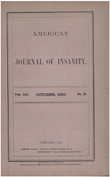Children's memories in the wake of Challenger
Abstract
OBJECTIVE: The Challenger spacecraft explosion of Jan. 28, 1986, offered an opportunity to study the memories of normal latency and adolescent children of different emotional involvements following one sudden and distant disaster. How would children of various levels of concern express their memories? And if studied over time, how would these narratives change? Would there be developmental differences? And would there be false details of memory? METHOD: The authors set out to compare the memories of 153 children from Concord, N.H. (who watched the explosion on television), and Porterville, Calif. (who heard about it). The structured-interview responses of involved and less involved children; latency-age versus adolescent children; and those seen initially (5-7 weeks after the explosion) versus those same children seen later (at 14 months) were statistically compared. RESULTS: The vast majority of children's memories of Challenger were clear, consistent, and detailed, with highlighting of personal placement, who else was there, and personal occurrences linked to the event. Those children who were less emotionally involved demonstrated significantly less clarity, consistency, and correct ordering of sequences and were less likely to remember personal placement, other people who were there, and related personal incidents. About 30% of all children in this study misunderstood something about Challenger and incorporated these misunderstandings into their memories as false details. Latency- age children continued to harbor false details for 14 months, as opposed to the adolescents. CONCLUSIONS: Childhood memories of the Challenger space shuttle explosion appeared predictable, were related to patterns of memory that have been observed following single, unrepeated traumas, and reflected age and stage differences.
Access content
To read the fulltext, please use one of the options below to sign in or purchase access.- Personal login
- Institutional Login
- Sign in via OpenAthens
- Register for access
-
Please login/register if you wish to pair your device and check access availability.
Not a subscriber?
PsychiatryOnline subscription options offer access to the DSM-5 library, books, journals, CME, and patient resources. This all-in-one virtual library provides psychiatrists and mental health professionals with key resources for diagnosis, treatment, research, and professional development.
Need more help? PsychiatryOnline Customer Service may be reached by emailing [email protected] or by calling 800-368-5777 (in the U.S.) or 703-907-7322 (outside the U.S.).



